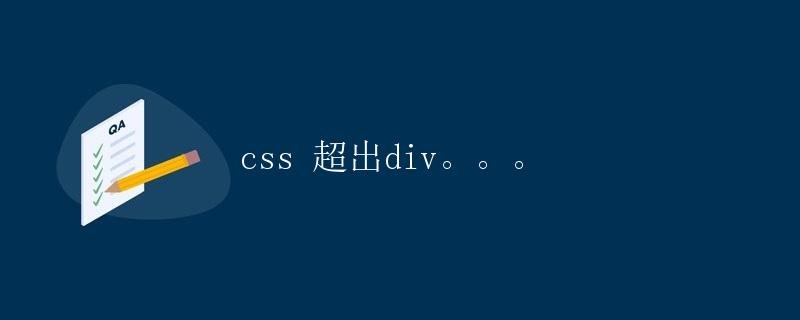How to handle CSS beyond div
How to handle CSS exceeding div
 In web development, we often encounter the problem of content exceeding the size of a container (a div), resulting in incomplete or distorted display. This requires CSS to address this issue. This article will detail some common CSS methods.
In web development, we often encounter the problem of content exceeding the size of a container (a div), resulting in incomplete or distorted display. This requires CSS to address this issue. This article will detail some common CSS methods.
Method 1: Using overflow
The overflow property controls how content within a container behaves when it exceeds the container’s size. Common values include the following:
visible: Content that exceeds the container will be displayed outside the container (default value)hidden: Content that exceeds the container will be hiddenscroll: Scroll bars will be displayed if the content exceeds the containerauto: Scroll bars will be displayed if the content exceeds the container, otherwise they will not be displayed
Sample code is as follows:
.div {
width: 200px;
height: 200px;
overflow: hidden;
}
Method 2: Use text-overflow
text-overflow is usually used to handle text overflow, and it can also play the same role in divs. Common values are as follows:
clip: Clips content that exceeds the container (only applies to inline elements)ellipsis: Displays an ellipsis to indicate clipped text
Sample code is as follows:
.div {
width: 200px;
white-space: nowrap;
overflow: hidden;
text-overflow: ellipsis;
}
Method 3: Using position
By setting the container’s position property to relative or absolute, and then setting overflow: hidden, you can hide the excess content when the content exceeds the container’s size.
Sample code is as follows:
.div {
width: 200px;
height: 200px;
position: relative;
overflow: hidden;
}
Method 4: Using Flex Layout
Flex layout makes it easy to handle situations where content exceeds the container size. By setting flex-direction: column and overflow: hidden, child elements can be hidden when they exceed the vertical size.
The sample code is as follows:
.container {
display: flex;
flex-direction: column;
height: 200px;
overflow: hidden;
}
Method 5: Using backface-visibility
The
backface-visibility property controls the visibility of an element’s backside, typically used for 3D transformations. However, it can also be used to hide overflowing content.
Sample code is as follows:
.div {
height: 200px;
backface-visibility: hidden;
}
Summary
Through the above methods, we can effectively handle situations where content exceeds the container size, ensuring a clean and aesthetically pleasing page display. In actual development, we can choose the appropriate method to handle overflowing content based on the specific situation, resulting in the best possible page presentation.